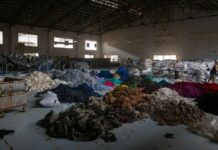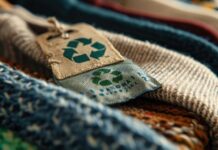The Science of Odor Control in Textiles: Advanced Technologies and Industry Standards for Combating Body Odor
Human body odor, while often invisible, poses a significant and persistent challenge in the world of textiles. Beyond being merely an unpleasant nuisance, body odor represents a critical consumer pain point that can dramatically impact brand perception, product longevity, and ultimately drive purchasing decisions across multiple textile segments. As the global odor control textiles market is projected to reach USD 9.84 billion by 2035, growing at a CAGR of 4.5%, the textile industry faces increasing pressure to develop scientifically rigorous, durable, and sustainable solutions to this complex challenge.
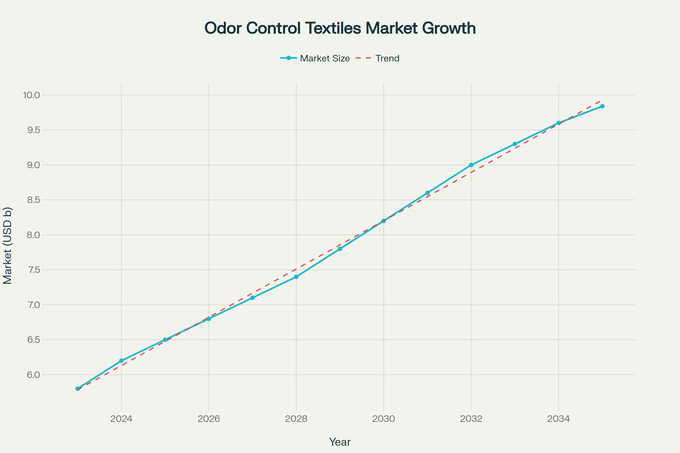
The Brand Reputation Imperative
For apparel brands operating in today’s hyper-competitive marketplace, maintaining odorless fabrics represents far more than a technical consideration—it constitutes a fundamental brand protection strategy. Consumer research consistently demonstrates that body odor and textile malodor significantly impact brand perception, with 75% of consumers perceiving odor in textiles as a problem that directly affects their confidence. When garments fail to manage odor effectively, brands face immediate consequences including increased product returns, negative online reviews, and erosion of customer loyalty. Premium athletic wear brands like Lululemon, Nike, and Adidas have invested heavily in odor control technologies precisely because malodorous performance wear can instantly undermine their positioning as technical innovation leaders. Similarly, intimate apparel and activewear brands understand that odor-related complaints spread rapidly through social media channels, potentially damaging years of brand building within hours. The reputational stakes are particularly high in the age of influencer marketing and viral content, where a single negative experience with odorous textiles can reach millions of potential customers, making proactive odor management not just a quality issue but a critical component of brand risk management strategy.
The Complex Chemistry of Human Body Odor
Contrary to common belief, human body odor cannot be attributed to a single source or compound. Instead, it represents a complex and dynamic mixture of volatile organic compounds (VOCs) that emerge from the intricate interplay between human biology, environmental factors, and textile substrates. The science reveals that body odor originates from the bacterial metabolism of apocrine sweat, particularly in axillary regions, where microorganisms such as Corynebacterium species convert odorless precursors into malodorous compounds.
The AATCC 2017 White Paper on Odor Evaluation Techniques confirmed this complexity through detailed odor intensity and character profiling, revealing that garments carry a broad array of olfactory signatures including animalic, earthy, floral, and chemical notes. This multifaceted nature demands equally sophisticated solutions that address not just surface symptoms but the underlying biochemical processes driving odor formation.
Research from the University of Ghent demonstrated significant differences between fabric types and their propensity for odor generation. Polyester textiles consistently produced stronger, more intense odors compared to cotton fabrics, with trained sensory panels identifying polyester as less pleasant and more odorous both before and after washing. This differential performance stems from synthetic fabrics’ tendency to promote selective enrichment of micrococci bacteria, which contribute significantly to malodor generation.
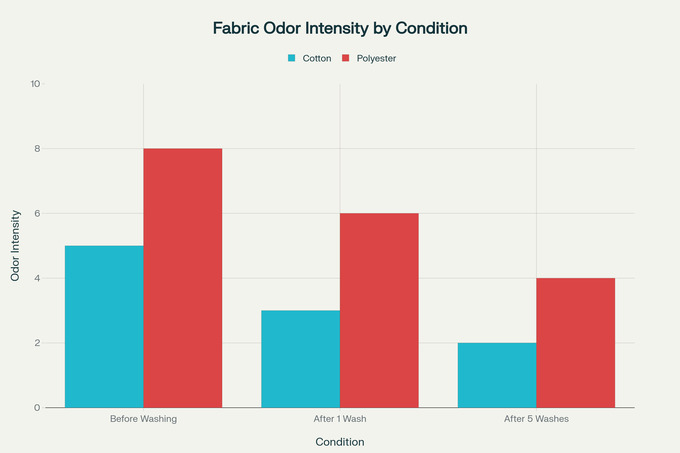
Global Industry Standards and Testing Protocols
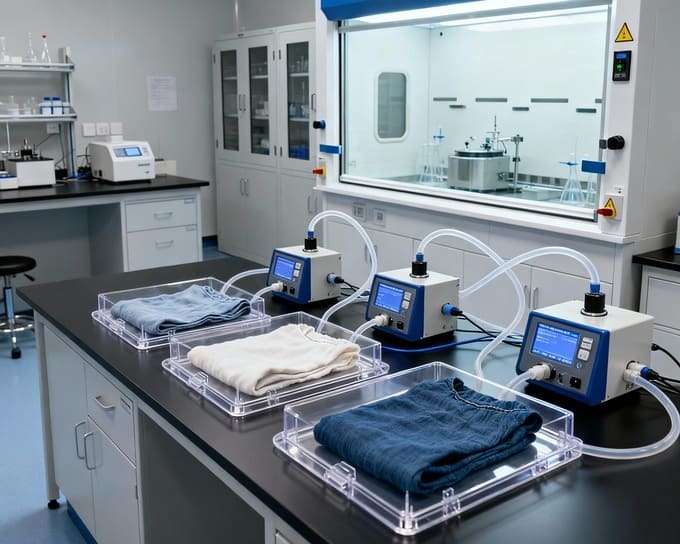
The textile industry has established comprehensive testing standards to evaluate odor control technologies, with international organizations leading standardization efforts. The ISO 17299 series represents the most significant advancement in odor testing protocols, with Part 3 specifically focusing on gas chromatography methods for determining deodorant properties in textiles. This standard quantifies how effectively textiles can reduce the presence of key odoriferous compounds including indole, isovaleric acid, nonenal, and acetic acid – all common components found in human sweat.
The American Association of Textile Chemists and Colorists (AATCC) has recently introduced AATCC TM216, a Test Method for Measuring the Odor Adsorbency of Textile Materials, developed in collaboration with the International Antimicrobial Council. This standardized method provides the textile value chain with reliable tools for evaluating emerging odor control technologies and ensuring their effectiveness under real-world conditions.
European regulations, particularly the Best Available Techniques (BAT) Reference Document for the Textiles Industry, establish environmental and safety standards for textile finishing processes. These guidelines ensure that odor control treatments meet stringent environmental criteria while maintaining effectiveness and durability throughout the product lifecycle.
Advanced Antimicrobial Technologies
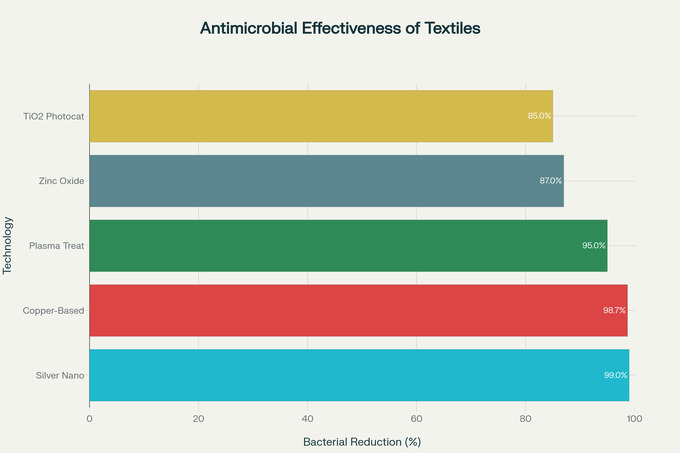
Silver Nanoparticle Systems
Silver nanoparticles (AgNPs) remain the most widely adopted antimicrobial technology in odor control textiles, achieving antimicrobial effectiveness of over 99% against both Gram-positive and Gram-negative bacteria. Recent advances in green synthesis using plant extracts like Azadirachta indica have improved wash durability while maintaining broad-spectrum antimicrobial activity. However, research indicates that silver release from textiles into artificial sweat ranges from 0 mg/kg to 322 mg/kg of fabric weight, raising questions about long-term safety and environmental impact.
Zinc Oxide Nanoparticles
Zinc oxide nanoparticles have emerged as a promising alternative, demonstrating significant antibacterial efficacy with 89.5% reduction in Staphylococcus aureus and 84.9% reduction in Escherichia coli colony-forming units. Two-sided coating applications show superior performance compared to single-sided treatments, with effectiveness particularly pronounced against Gram-negative bacteria. The technology offers the additional benefit of UV protection while maintaining biocompatibility and reduced environmental concerns compared to silver-based systems.
Copper-Based Solutions
Copper-infused textiles leverage the metal’s natural antimicrobial properties to provide both bacterial control and odor management. Laboratory studies demonstrate over 98.7% reduction in viable bacteria, fungi, and viruses within 20 minutes to 4 hours of exposure to copper-impregnated fabrics. The technology works by releasing copper ions that interfere with bacterial cell membranes and enzymatic processes, effectively disrupting odor-causing microbial populations.
Innovative Odor Control Technologies
Photocatalytic Systems
Titanium dioxide (TiO₂) photocatalytic coatings represent a breakthrough in self-cleaning and odor-eliminating textiles. When exposed to UV light, TiO₂ generates reactive oxygen species that decompose organic pollutants, including odor-causing compounds, into harmless substances like carbon dioxide and water. Recent developments combining TiO₂ with reduced graphene oxide show photocatalytic efficiencies exceeding 60% with excellent wash durability.
Plasma Treatment Technologies
Cold atmospheric plasma treatment offers a chemical-free approach to odor control, generating reactive species that eliminate bacteria and neutralize odorous compounds. Research demonstrates 51% reduction in 3-hydroxy-3-methylhexanoic acid and 34% reduction in 3-methyl-3-sulfanylhexan-1-ol – primary components of axillary odor – following 5-minute plasma exposure. The technology provides dual functionality of bacterial sterilization and odor elimination without chemical additives.
Advanced Polymer Technologies
Proprietary polymer systems like Freshology utilize complex blends of polymers and natural components to capture and neutralize VOCs through physical and chemical interactions. These technologies demonstrate effectiveness against all four primary odorants identified in ISO 17299 standards while maintaining durability through numerous home launderings. The Livinguard Better Fresh technology combines biocide-free odor control with microfiber reduction capabilities, achieving up to 99% reduction in relevant odorants while reducing fiber shedding by over 70%.
Microencapsulation and Controlled Release Systems
Microencapsulation technology enables controlled release of active ingredients, including fragrances, antimicrobials, and odor-neutralizing compounds. Temperature-sensitive microcapsules can provide targeted release when body heat activates the system, offering sustained odor control throughout wear cycles. This technology allows for dual-functionality products that both prevent odor formation and provide pleasant fragrance release on demand.
Sustainability and Environmental Considerations
The industry increasingly emphasizes sustainable odor control solutions that minimize environmental impact while maintaining performance. Biodegradable antimicrobial agents derived from natural sources offer promising alternatives to synthetic treatments. Enzyme-based cleaning systems provide eco-friendly approaches to odor removal, utilizing proteases, lipases, and amylases to break down specific odor-causing compounds without harsh chemicals.
Research into natural antimicrobial resources demonstrates that plant-based extracts and bio-derived compounds can achieve comparable performance to synthetic alternatives while offering improved biodegradability and reduced toxicity. These developments align with evolving regulatory frameworks like the EU Strategy for Sustainable and Circular Textiles, which emphasizes circular economy principles and reduced environmental impact.
Consumer Perception and Market Dynamics
Consumer research reveals that 75% of consumers perceive odor in textiles as a problem, with 90% reporting that body and textile odors impact their confidence. However, awareness of anti-odor functionalities remains surprisingly low, with consumers primarily relying on post-treatment solutions like increased washing frequency rather than seeking products with built-in odor control technologies.
HeiQ’s comprehensive consumer research indicates that while consumers find odor control appealing and are willing to pay a 15% price premium for textiles with odor control functionality, extensive communication and education about these technologies remains crucial for market adoption. The research emphasizes the importance of ingredient branding and consumer education to bridge the knowledge gap between available technologies and consumer awareness.
Future Directions and Technological Convergence
The future of odor control in textiles lies in the convergence of multiple technologies and approaches. Combination treatments that integrate antimicrobial agents with odor capture mechanisms, photocatalytic self-cleaning properties, and sustainable release systems offer comprehensive solutions to the complex odor challenge.
Nanotechnology continues to drive innovation, with developments in nanostructured materials, smart textiles, and responsive systems that adapt to environmental conditions and user needs. The integration of Internet of Things (IoT) sensors and smart monitoring systems may eventually enable real-time odor detection and automated treatment activation.
As the global textile industry faces increasing pressure to address sustainability concerns while meeting performance expectations, odor control technologies must evolve to provide durable, effective, and environmentally responsible solutions. The industry’s success in mastering these complex challenges will ultimately determine its ability to meet consumer demands while advancing toward a more sustainable and technologically sophisticated future.
The science of odor control in textiles represents a fascinating intersection of chemistry, microbiology, materials science, and consumer psychology. As our understanding of these complex interactions deepens, the industry is well-positioned to develop increasingly sophisticated solutions that not only eliminate unwanted odors but also enhance overall textile performance and user experience. Success in this field requires a comprehensive approach that addresses the multifaceted nature of body odor while maintaining focus on sustainability, durability, and consumer satisfaction.

























